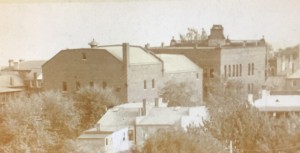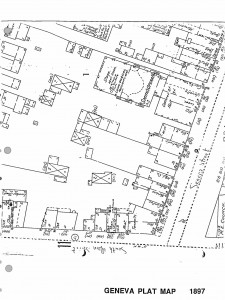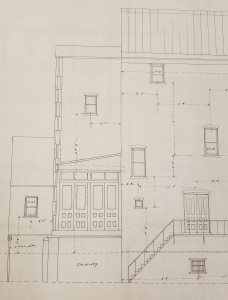SMITH HISTORY BLOG: Two buildings into one: Opera House and Office Buildings as separate entities

This old picture of the rear of the Smith clearly shows the two separate buildings. The back of the top of the facade can be seen on the front building. Next time you’re on Castle Street, look out for the back wall of the rear building in this picture.Courtesy of the HWS Archives (Panorama of Geneva).
by Austin Jennings
It might be difficult to believe now, but originally the Smith Opera House stage and the facade that reads “Smith’s Opera House” were each part of two completely separate buildings. The front building, adorned with the ornate facade, contained stores on its first floor, offices on its second, and William Smith’s Hall of Science lecture hall on its third (Pierce and Bickford Architects). Unlike today, the front archway did not lead to a short vestibule and then a wide lobby. When walking through the archway, people would enter a long, relatively narrow hallway that went through the entire front building. This hallway provided access to the stores as well as stairs to the upper levels of the front building. At the very end, the hallway also provided access to the rear building through a covered connecting passageway (Pierce and Bickford Architects).

From this map, the main hallway, the passageway, and the driveway connected to the alleyways on either side of the buildings can be better visualized. Courtesy of the Smith Opera House archives (Crawford and Stearns 17).
Not much is presently known about this passageway structure, though it would seem that it was not as tall as either of the two buildings that it connected, and it has been described as being above a driveway for horse and buggies ( Geneva Daily Gazette). This driveway between the two buildings was parallel to Seneca Street and connected to the alleyways that were (and still currently are) on either side of the Smith (Crawford and Stearns 17). In the middle of the driveway on the rear building was a door, which opened to a flight of stairs leading up to the first floor of the opera house (Geneva Daily Gazette). It is possible, then, that those traveling in a horse and buggy to the Smith could be dropped off at this entrance after turning down one of the alleyways from Seneca Street and turning onto this driveway. Those who walked to see an event at the Smith, however, would go through the main archway, all the way down the long hallway, through the connecting passageway, and then into the rear building (Crawford and Stearns 14). It was there, in that rear building, where patrons could enter the opera house auditorium.
These days, of course, the Smith Opera House is all one building. That change occurred when Schine Enterprises bought the opera house in 1927 and renovated it to become Schine’s Geneva Theatre (McNally 4). Since the 1894 facade of the front building and the 1894 rear wall of the rear building still exist, it is clear that Schine Enterprises combined the two original buildings. While those exterior walls remain, the interiors of the original buildings were completely demolished (Crawford and Stearns 31).

This plan for the connecting passageway and the front of the rear building shows what the driveway and its stairs may have looked like. It is unclear whether or not these exact plans were used when building this section of the original Smith, though the final product was probably not much different, if at all. Courtesy of the Olin Library at Cornell University (Pierce and Bickford).